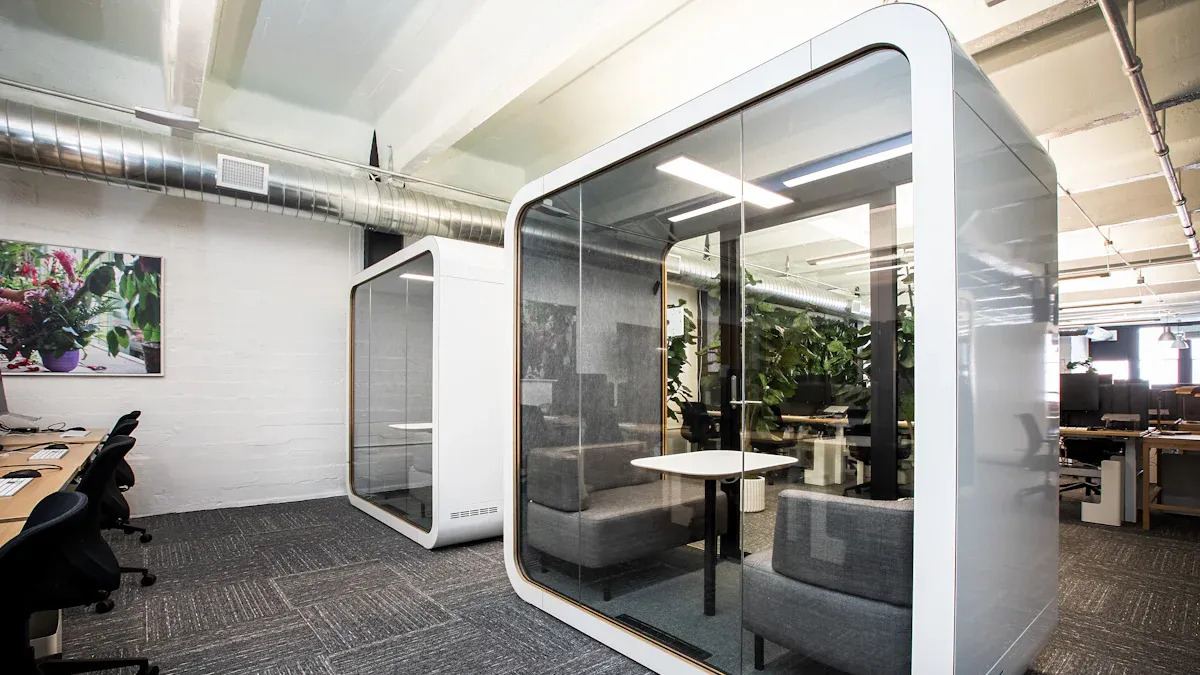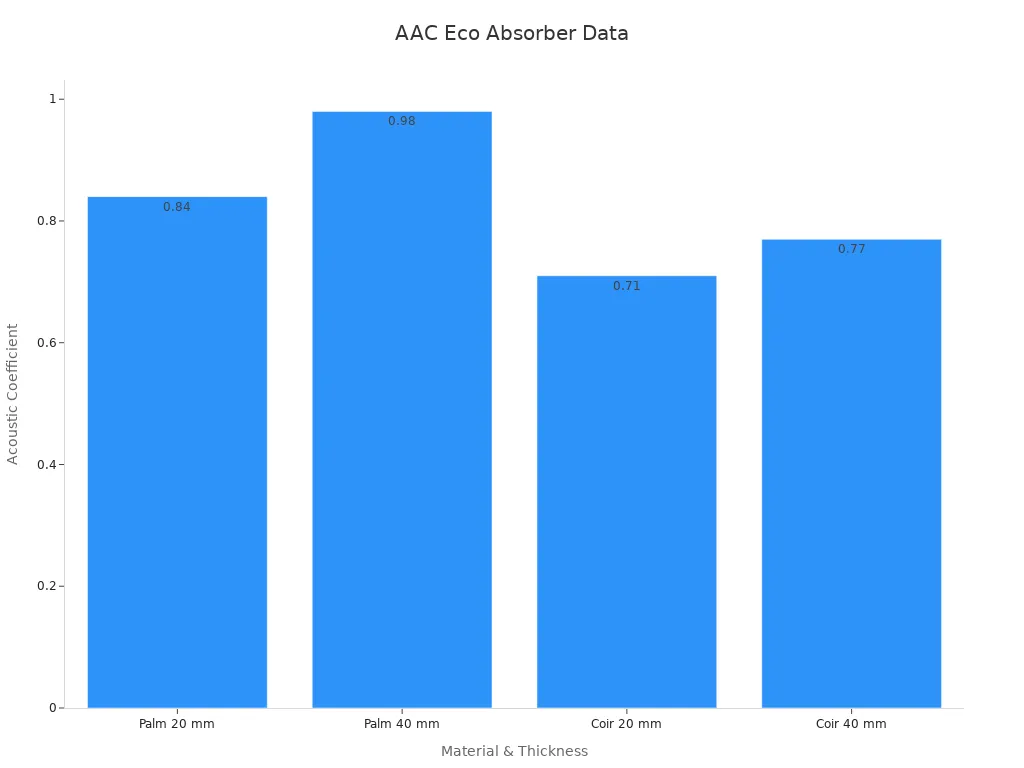
The demand for sound proof booths has surged across diverse sectors due to evolving needs for quieter environments. Educational institutions increasingly adopt these sound proof booths to enhance remote learning, as sound quality directly impacts students’ focus. In workplaces, over 70% of employees report noise as a productivity barrier, leading to the installation of office privacy pods. Broadcasting and media industries also require multi-function silent booths to achieve superior audio fidelity. By integrating sustainable practices, eco-friendly sound proof booths not only address these demands but also contribute to environmental preservation. They offer a perfect blend of acoustic efficiency and green innovation.
Sustainable Materials in Sound Proof Booths

Recycled PET Panels for Noise Absorption
Recycled PET panels have emerged as a leading solution for noise absorption in sound proof booths. These panels, crafted from recycled PET bottles, exemplify sustainability by repurposing waste materials into functional acoustic solutions. Their design effectively absorbs sound waves, reducing reverberation and controlling echoes in enclosed spaces. This makes them ideal for environments requiring enhanced concentration and communication, such as offices, classrooms, and recording studios.
- Key Benefits of Recycled PET Panels:
- They improve acoustic comfort by minimizing noise transmission.
- Their lightweight yet durable structure ensures easy installation and long-term use.
- By utilizing recycled materials, they contribute to reducing plastic waste and promoting a circular economy.
For example, Envirotech PET Acoustic Panels demonstrate how recycled PET can enhance productivity in noisy environments while supporting environmental goals. These panels not only meet acoustic performance standards but also align with the growing demand for eco-conscious sound proof booths.
Natural Fibers and Renewable Resources
Natural fibers and renewable resources offer a sustainable alternative to synthetic materials in sound proof booths. Materials like hemp, cork, flax, and bamboo provide excellent acoustic benefits while maintaining a low environmental footprint. Their renewable and biodegradable nature ensures minimal impact on the planet.
| Material | Acoustic Benefits | Sustainability Credentials |
|---|---|---|
| Hemp | Strong sound absorption | Renewable, biodegradable, locally sourced |
| Cork | Effective sound dampening | Renewable, biodegradable, locally sourced |
| Flax | Good sound absorption properties | Renewable, biodegradable, locally sourced |
| Bamboo | Effective in reducing noise levels | Renewable, biodegradable, locally sourced |
Additionally, wool serves as another renewable option with superior sound absorption properties. Hemp, in particular, stands out for its ability to reduce environmental impact while delivering high acoustic performance. These materials not only enhance the functionality of sound proof booths but also align with the principles of sustainable design.
Low-VOC Adhesives and Eco-Friendly Coatings
Low-VOC (volatile organic compound) adhesives and eco-friendly coatings play a crucial role in the construction of sustainable sound proof booths. Traditional adhesives and coatings often release harmful chemicals into the air, compromising indoor air quality. In contrast, low-VOC alternatives minimize these emissions, creating healthier indoor environments.
- Advantages of Low-VOC Adhesives and Coatings:
- They reduce the release of toxic substances, ensuring safer usage in confined spaces.
- Their application supports compliance with green building certifications, such as LEED.
- They enhance the durability and aesthetic appeal of sound proof booths without compromising sustainability.
By incorporating these eco-friendly solutions, manufacturers like Ningbo Cheerme Intelligent Furniture Co., Ltd. demonstrate their commitment to creating high-performance, environmentally responsible sound proof booths. These innovations not only improve acoustic efficiency but also contribute to achieving carbon neutrality goals.
Modular and Scalable Design of Sound Proof Booths
Flexible Assembly for Various Spaces
Modular sound proof booths offer unmatched flexibility in adapting to diverse spatial configurations. Their design prioritizes ease of assembly, allowing users to customize booth layouts based on specific requirements. Whether for open-plan offices, educational institutions, or broadcasting studios, these booths integrate seamlessly into existing environments.
| Feature | Description |
|---|---|
| Modular Designs | Configurable layouts tailored to spatial needs. |
| Customizable Sizes | Multiple size options to fit varying room dimensions. |
| High Level of Attenuation | Effective soundproofing comparable to premium booths. |
| Quick Delivery | Delivered within 4 weeks for rapid deployment. |
| Upgradeable and Expandable | Features can be added or expanded as needed. |
These features ensure that sound proof booths remain versatile and practical for evolving spatial demands. Ningbo Cheerme Intelligent Furniture Co., Ltd. exemplifies this adaptability by offering booths that combine portability with high-performance sound isolation.
Reduced Waste Through Modular Production
Modular production methods significantly reduce material waste during manufacturing. By utilizing prefabricated components, manufacturers streamline production processes and minimize resource consumption. This approach supports sustainability goals while maintaining high-quality standards.
| Benefit | Description |
|---|---|
| Cost-effectiveness | Reduces the need for large real estate investments. |
| Flexibility | Enables relocation or expansion as office needs change. |
| Productivity enhancements | Creates distraction-free environments for improved focus. |
Cheerme’s modular production techniques align with its commitment to building a sustainable prefabricated housing ecosystem. These methods not only lower costs for users but also contribute to achieving carbon neutrality.
Reusability and Longevity of Components
Eco-friendly sound proof booths are designed for durability and repeated use. Their components undergo rigorous testing to ensure long-term reliability. Features like a 10-year guarantee against structural failure and the ability to disassemble and reassemble components make these booths ideal for sustainable use.
| Feature | Description |
|---|---|
| 10 Year Guarantee | Ensures structural integrity for a decade. |
| Eco-friendly | Minimizes carbon footprint while supporting sustainable practices. |
| Reusability | Facilitates repeated assembly and disassembly for convenience and longevity. |
Cheerme’s sound proof booths exemplify this durability, offering users a reliable solution that balances acoustic performance with environmental responsibility. Their modular design ensures that components remain functional and reusable, reducing waste and promoting sustainability.
Acoustic Performance and Environmental Benefits
Enhancing Noise Isolation with Sustainable Materials
Sustainable materials significantly improve the noise isolation capabilities of sound proof booths. By utilizing eco-friendly components such as recycled PET panels and natural fibers, manufacturers achieve superior acoustic performance while reducing environmental impact. These materials effectively block external noise, creating quieter spaces for work, study, or recording.
A comparative analysis of acoustic performance metrics demonstrates the improvements achieved through sustainable materials:
| Acoustic Performance Metric | Before Eco Line | After Eco Line | Improvement |
|---|---|---|---|
| Reverberation Reduction | N/A | 20% more efficient | Yes |
| Noise Isolation | N/A | Enhanced | Yes |
This data underscores the dual benefits of sustainable materials—enhanced noise isolation and environmental responsibility. Ningbo Cheerme Intelligent Furniture Co., Ltd. exemplifies this approach by integrating high-performance, eco-friendly materials into their sound proof booths, ensuring both functionality and sustainability.
Reducing Reverberation Using Eco-Friendly Absorbers
Eco-friendly absorbers, such as natural fibers and plant-based materials, play a pivotal role in reducing reverberation within sound proof booths. These materials absorb sound waves effectively, minimizing echoes and improving acoustic clarity. Advanced testing methods validate their performance across various frequency ranges.
| Measurement Technique | Material Tested | Sound Absorption Coefficient (SAC) | Frequency Range (Hz) |
|---|---|---|---|
| Reverberation Room | Natural Fibers | Comparable to mineral wool | Various |
| Impedance Tube | Date Palm Fiber | 0.98 at 1381.25-1506.25 | 1381.25-1506.25 |
| Impedance Tube | Coconut Coir | 0.77 at 2434.38-2543.75 | 2434.38-2543.75 |
Additionally, the thickness of these materials influences their acoustic absorption properties. For instance, date palm fiber with a thickness of 40 mm achieves a sound absorption coefficient of 0.98, making it highly effective for soundproofing applications.

These findings highlight the potential of eco-friendly absorbers to enhance acoustic performance while adhering to sustainable design principles.
Balancing Acoustic Efficiency with Green Design
Balancing acoustic efficiency with green design requires a thoughtful selection of materials and adherence to sustainability guidelines. Analytical studies reveal that regional acoustical standards increasingly promote eco-friendly construction practices. Manufacturers now prioritize recycled materials and renewable resources to align with these trends.
- Sustainability trends influence acoustical guidelines regionally, promoting eco-friendly construction practices.
- Regulations encourage the use of recycled materials or sustainably sourced components.
- Manufacturers adapt strategies to appeal to environmentally conscious consumers seeking green-certified products.
Ningbo Cheerme Intelligent Furniture Co., Ltd. exemplifies this balance by designing sound proof booths that meet stringent acoustic performance standards while supporting carbon neutrality goals. Their innovative approach ensures that users benefit from quieter environments without compromising environmental integrity.
Certifications and Standards for Sound Proof Booths
Green Building Certifications (e.g., LEED)
Green building certifications, such as LEED (Leadership in Energy and Environmental Design), set benchmarks for the sustainability of soundproof booths. These certifications evaluate products based on their environmental impact and energy efficiency. For soundproof booths, specific criteria include:
- Maximum background noise levels in sensitive rooms must not exceed 40 dBA.
- Exterior windows and doors should have a minimum STC (Sound Transmission Class) rating of 35 in noisy areas.
- Party walls and floor/ceiling assemblies must achieve an STC rating of at least 55.
- Floor/ceiling assemblies should also meet a minimum IIC (Impact Insulation Class) rating of 55.
These standards ensure that soundproof booths not only provide effective noise isolation but also align with sustainable construction practices. Manufacturers like Ningbo Cheerme Intelligent Furniture Co., Ltd. design their products to meet these rigorous requirements, supporting both acoustic performance and environmental goals.
Acoustic Performance Testing and Standards
Acoustic performance testing validates the effectiveness of soundproof booths in reducing noise and improving sound quality. Testing methods assess factors such as reverberation reduction, noise isolation, and sound absorption. For example, intermittent fans in soundproof booths must not exceed a sound rating of 1.5 sones unless airflow surpasses 400 cfm. Additionally, ducts and fan housings must be securely attached to prevent noise leakage.
These tests ensure that soundproof booths meet industry standards for acoustic efficiency. By adhering to these benchmarks, manufacturers deliver products that enhance user experiences in offices, classrooms, and recording studios.
Validating Sustainability with Third-Party Certifications
Third-party certifications play a crucial role in validating the sustainability of soundproof booths. Certifications such as UL GREENGUARD and FSC (Forest Stewardship Council) confirm that products meet stringent environmental and health standards.
| Certification | Description | Benefits |
|---|---|---|
| UL GREENGUARD | Ensures low emissions and compliance with chemical standards. | Reduces indoor air pollution and supports LEED and BREEAM certifications. |
| SCS Indoor Advantage GOLD | Certifies low VOC emissions and indoor air quality. | Recognized by EPA and GSA, qualifies for LEED v4 and WELL Building. |
| PEFC | Validates sustainable sourcing of wood. | Ensures timber comes from well-managed forests. |
| FSC | Certifies responsible sourcing of wood materials. | Promotes environmentally and socially beneficial practices. |
These certifications provide transparency and build consumer trust, ensuring that soundproof booths meet both performance and sustainability expectations.
Eco-friendly sound proof booths offer a unique combination of noise reduction, sustainability, and adaptability. They enhance acoustic comfort while supporting environmental goals, making them ideal for diverse applications.
Adopting sustainable soundproofing solutions benefits industries like healthcare, aerospace, and construction. These solutions create quieter, more comfortable environments while addressing environmental concerns.
Explore eco-friendly sound proof booths today to transform personal and professional spaces into sustainable, noise-free havens.
FAQ
What makes eco-friendly soundproof booths sustainable?
Eco-friendly soundproof booths use recycled materials, renewable resources, and low-VOC adhesives. These components reduce environmental impact while maintaining high acoustic performance.
How do modular designs contribute to sustainability?
Modular designs minimize waste during production. They allow easy assembly, disassembly, and reusability, ensuring long-term use and adaptability to changing needs.
💡 Tip: Modular soundproof booths from Ningbo Cheerme Intelligent Furniture Co., Ltd. offer scalable solutions that align with carbon neutrality goals.
Are eco-friendly soundproof booths certified for quality?
Yes, many booths meet certifications like LEED and UL GREENGUARD. These validate their sustainability, acoustic performance, and compliance with environmental standards.

